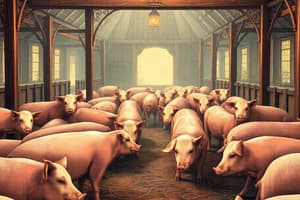Podcast
Questions and Answers
What is the age range for pigs to be fed Grower/ Fattener Feed?
What is the age range for pigs to be fed Grower/ Fattener Feed?
- 4-12 weeks
- 13-24 weeks (correct)
- 13-18 weeks
- 4-18 weeks
Which type of ventilation system is typically recommended for farrowing and nursery pigs?
Which type of ventilation system is typically recommended for farrowing and nursery pigs?
- Natural Ventilation
- Neutral Pressure Barns
- Negative Pressure Barns (correct)
- Positive Pressure Barns
What is the primary purpose of regular health monitoring and prompt treatment of illnesses in swine?
What is the primary purpose of regular health monitoring and prompt treatment of illnesses in swine?
- To improve overall health and productivity (correct)
- To decrease productivity
- To increase pig size
- To reduce ventilation costs
When is Dry Sow Feed typically given to pigs?
When is Dry Sow Feed typically given to pigs?
Why are ventilation systems important in intensive pig production?
Why are ventilation systems important in intensive pig production?
Which feed is specifically given to lactating sows?
Which feed is specifically given to lactating sows?
What is one of the main concerns regarding intensive swine farming?
What is one of the main concerns regarding intensive swine farming?
Why is waste management crucial in intensive swine farming?
Why is waste management crucial in intensive swine farming?
What is the purpose of individual feeding and medication in intensive swine farming?
What is the purpose of individual feeding and medication in intensive swine farming?
What type of feed is given to piglets as early as 10 days old?
What type of feed is given to piglets as early as 10 days old?
'Sow stalls and farrowing crates' have sparked controversy in intensive swine farming due to:
'Sow stalls and farrowing crates' have sparked controversy in intensive swine farming due to:
Flashcards
Early Weaning
Early Weaning
The process of separating piglets from their mother at 4 weeks of age.
Weaner Feed
Weaner Feed
Feed specifically designed for piglets from 4 weeks to 12-14 weeks of age.
Grower Feed
Grower Feed
Feed for pigs between 13 and 18 weeks old, focusing on muscle growth.
Grower/Fattener Feed
Grower/Fattener Feed
Signup and view all the flashcards
Dry Sow Feed
Dry Sow Feed
Signup and view all the flashcards
Lactating Sow Feed
Lactating Sow Feed
Signup and view all the flashcards
Creep Feed
Creep Feed
Signup and view all the flashcards
Intensive Swine Farming
Intensive Swine Farming
Signup and view all the flashcards
Mechanical Ventilation (Negative Pressure)
Mechanical Ventilation (Negative Pressure)
Signup and view all the flashcards
Mechanical Ventilation (Positive Pressure)
Mechanical Ventilation (Positive Pressure)
Signup and view all the flashcards
Record Keeping and Data Management
Record Keeping and Data Management
Signup and view all the flashcards
Study Notes
Swine Feed
- Early weaning is done at 4 weeks
- Weaner Feed is given to pigs from weaning to about 12-14 weeks of age
- Growers Feed is fed to pigs from 13 to around 18 weeks
- Grower/Fattener Feed is fed to pigs from 13 weeks to 24 weeks for those operating under fattening operation
- Dry Sow Feed is fed to pregnant pigs, boar and those under dry period
- Lactating Sow Feed is fed to lactating sows
- Creep Feed is given to piglets as early as 10 days and piglets continue to feed on it up to 1 week after weaning
Veterinary Care and Health Monitoring
- Regular health monitoring and prompt treatment of illnesses are essential for maintaining overall health and productivity of swine
- Veterinary care and vaccination programs are important for preventing and controlling diseases within the swine herd
Ventilation Systems
- Intensive pig production needs ventilation systems to regulate moisture, heat, and air pollution
- Types of ventilation systems include: Mechanical Ventilation (Negative Pressure Barns, Positive Pressure Barns, and Neutral Pressure Barns) and Natural Ventilation
- Mechanical ventilation is typically recommended for farrowing and nursery pigs to control air temperature
Intensive Swine Farming
- Also known as factory farming, it maximizes pig production using high-density housing, controlled environments, automated feeding, advanced breeding, and antibiotics
- Criticized for its impact on animal welfare, as it often restricts pigs' movement and natural behaviors, leading to stress and injuries
- Five aspects of an intensive farming system include record keeping, breed selection, waste management, individual feeding and medication, and disease prevention
Aspects of Intensive Swine Farming System
- Record Keeping and Data Management: tracking individual pig performance, feed consumption, health records, and production parameters
- Choosing the right breed of pigs: breeding for traits such as growth rate, feed efficiency, and disease resistance
- Waste Management: using lagoon and spray field method to minimize environmental impact and prevent pollution
- Individual Feeding and Medication: confining pigs in individual stalls for individual feeding and medication, using veterinary care, vaccination programs, and biosecurity measures to prevent and control diseases
Studying That Suits You
Use AI to generate personalized quizzes and flashcards to suit your learning preferences.




